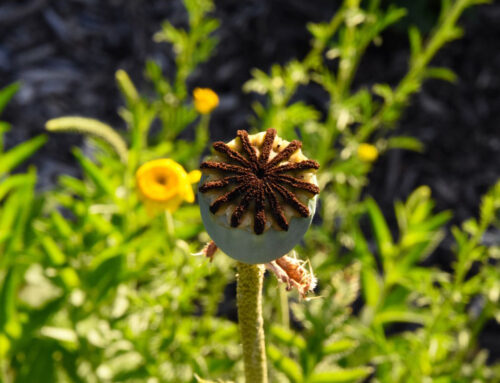Every year during the last week of July, nature lovers around the world celebrate those unsung heroes of night pollination: moths. Sadly, moths are often overshadowed (pun intended) by their better-known cousins in the Lepidoptera order – butterflies. But today, I’m going to give our feathery flying friends some much deserved respect and share why moths are so incredible and why they are critically important to our ecosystems.
Here are some differences between butterflies and moths:
Butterflies
- Active Time: Diurnal (active during the day)
- Antennae: Thin with a clubbed tip
- Wings at Rest: Hold wings upright and together
- Coloration: Often bright and colorful
- Body: Slim and smooth
- Cocoon Type: Form a chrysalis (smooth and hard)
- Behavior: Graceful flyers, often seen fluttering among flowers
- Symbolism: Often associated with beauty, transformation, and joy
Moths
- Active Time: Nocturnal (active at night)
- Antennae: Feathery or threadlike, not clubbed
- Wings at Rest: Hold wings flat or tented over their body
- Coloration: Usually dull or earth-toned, though some are colorful
- Body: Fuzzy and thick
- Cocoon Type: Spin a silken cocoon
- Behavior: Attracted to lights, can appear clumsy in flight
- Symbolism: Often connected to mystery, attraction, and the unseen
And Some Interesting Facts About Moths:
Moths are important pollinators. Long before bees got all the credit, moths were pollinating night-blooming plants.
Many moths visit flowers for nectar and unknowingly transfer pollen, just like bees and butterflies.
Moths are especially important for night-blooming plants, like jasmine, yucca, and evening primrose. Some plants rely exclusively on moths for pollination (e.g., the yucca plant and yucca moth have a mutual survival relationship).
Many moths are masters of camouflage – They may resemble bark, leaves, or even bird poop to hide from predators. Some moths mimic butterflies to avoid predators.
The adult Luna moth doesn’t have a mouth. It lives just a few days—long enough to mate and lay eggs.
Moths can be furry. Some, like the Rosy Maple moth, look like flying stuffed animals.
Not all moths are brown. Some are neon pink, turquoise, or metallic gold (like the Madagascan sunset moth).
Moths make up 90% of the Lepidoptera order. There are about 160,000 moth species, compared to only about 17,500 butterfly species.
The Hercules moth (Australia) has the largest wingspan of any moth—up to 10.6 inches.
Moths have extraordinary low-light vision—some see UV light, which helps them navigate at night and find flowers that glow under UV.
Silk comes from a moth. The domesticated silkworm (Bombyx mori) has been bred for over 5,000 years.
Some moths are believed to use the Earth’s magnetic field to migrate, just like birds.
Certain moths have ears on their abdomens that can detect echolocation clicks from bats.
While some moths are pests, many are pollinators, food sources for birds, and play an essential role in the garden food web.
The Death’s-head Hawkmoth, famous from The Silence of the Lambs, has a skull-shaped marking on its thorax—and can squeak when disturbed.
Not all moths are nocturnal. Some moths, like the Hummingbird Clearwing Moth, fly during the day and mimic hummingbirds.
Moths have superpower scent tracking – Male moths can smell a female’s pheromones from up to seven miles away.
Moths’ fuzzy bodies help with flight – Those scales and hairs aren’t just pretty—they help with aerodynamics and thermal regulation.
Wings like fingerprints – Each moth species has unique wing patterns, often used by scientists for ID like a barcode.
Woolly bear weather prediction – The woolly bear caterpillar, larva of the Isabella tiger moth, is said to predict winter severity based on its stripe pattern. However, this is more folklore than fact.
Moths are important decomposers and recyclers. Some moth species, like the wax moth, help break down natural materials like beeswax and old wood. Others feed on decaying plant matter, aiding in nutrient cycling in ecosystems.
Moths are biodiversity indicators. Moth populations are highly sensitive to climate change, pollution, and habitat loss. Scientists use moths as bioindicators to monitor environmental health. A thriving moth population = a healthy, balanced ecosystem.
Moths inspired radar – The stealth of moth wings helped researchers develop quieter airplane tech by mimicking their sound-dampening scales.
Moths’ eyes helped to invent anti-glare screens and light-absorbing materials due to their unique structure.
Moth wing scales have led to innovations in nano-materials and climate-adaptive fabrics.
How Can We Support Moth Populations?
Create a moth-friendly garden by planting a variety of native flowers, especially those that bloom at different times of the year and release their scent at night.
Reduce pesticide use.
Leave areas of your garden wild, including leaf litter, to provide overwintering habitats for caterpillars and pupae.
Make time to notice moths. Take a walk outside and observe and appreciate moth activity during the evening and night the next time you’re out in your garden. These often unassuming and under-appreciated late-hour pollinators are quietly doing essential work for the planet.
Have a great week.
Pam








